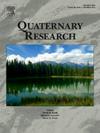The distribution of fossil pollen and charcoal in stalagmites
IF 1.8
3区 地球科学
Q3 GEOGRAPHY, PHYSICAL
引用次数: 1
Abstract
Pollen preserved in caves provides a little-appreciated opportunity to study past vegetation and climate changes in regions where conventional wetland sediments are either unavailable, contain little organic matter, and/or are difficult to date accurately. Most palynology in caves has focused on clastic infill sediments, but pollen preserved in growing speleothems provides important new opportunities to develop vegetation and climatic records that can be dated accurately with radiometric methods. However, when pollen is present in speleothems, concentrations can vary by orders of magnitude, highlighting how little we know about the processes that transport pollen into caves and onto speleothem surfaces, and that determine the pollen's preservation probability. To explore these aspects of speleothem pollen taphonomy, we investigated the distribution of pollen and microscopic charcoal within several stalagmites from southwest Australia. We examined spatial patterns in pollen and charcoal preservation in order to distinguish whether observed gradients result from preservation or are products of systematic transport processes working along stalagmite surfaces. We find that pollen grains and charcoal fragments are located preferentially on the flanks of most stalagmites. This suggests that pollen grain and charcoal deposition on speleothems is influenced by transport and accumulation of detrital debris on growing surfaces. These insights will assist in future sampling campaigns focusing on speleothem pollen and charcoal contents.石笋中化石花粉和木炭的分布
保存在洞穴中的花粉为研究过去的植被和气候变化提供了一个鲜为人知的机会,在这些地区,传统的湿地沉积物要么不可用,要么含有很少的有机物,或者很难准确地确定年代。大多数洞穴孢粉学都集中在碎屑填充沉积物上,但在生长的洞穴中保存的花粉为开发植被和气候记录提供了重要的新机会,这些记录可以用辐射测量法准确地确定年代。然而,当花粉存在于洞穴中时,其浓度可能会发生数量级的变化,这表明我们对花粉进入洞穴并到达洞穴表面的过程知之甚少,而这一过程决定了花粉的保存概率。为了探讨石笋花粉分类的这些方面,我们对澳大利亚西南部几种石笋的花粉和显微炭的分布进行了研究。我们研究了花粉和木炭保存的空间格局,以区分所观察到的梯度是保存的结果还是沿着石笋表面系统运输过程的产物。我们发现花粉粒和木炭碎片优先位于大多数石笋的侧翼。这表明花粉粒和木炭在洞穴上的沉积受到生长表面碎屑运输和堆积的影响。这些见解将有助于未来的采样活动,重点关注洞穴花粉和木炭含量。
本文章由计算机程序翻译,如有差异,请以英文原文为准。
求助全文
约1分钟内获得全文
求助全文
来源期刊

Quaternary Research
地学-地球科学综合
CiteScore
4.70
自引率
8.70%
发文量
57
审稿时长
3 months
期刊介绍:
Quaternary Research is an international journal devoted to the advancement of the interdisciplinary understanding of the Quaternary Period. We aim to publish articles of broad interest with relevance to more than one discipline, and that constitute a significant new contribution to Quaternary science. The journal’s scope is global, building on its nearly 50-year history in advancing the understanding of earth and human history through interdisciplinary study of the last 2.6 million years.
 求助内容:
求助内容: 应助结果提醒方式:
应助结果提醒方式:


